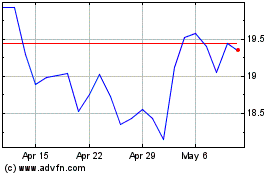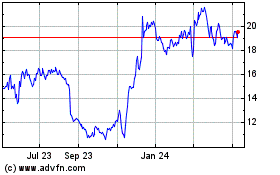Brooklyn Macy's Is Set for a Major Renovation
April 06 2016 - 9:13PM
Dow Jones News
Keiko Morris
Macy's Inc. is bringing together the past and the present in a
$100 million renovation of its store in downtown Brooklyn.
The retailer will take three years to revamp the building at 422
Fulton St., which was built in 1873 and expanded in 1929 and 1947.
The store will remain open during the makeover, and demolition will
start in a few weeks.
The overhaul will add fluted columns and coffered ceilings on
the first floor, along with arched metal-and-glass canopies over
the Fulton Street entrances, as nods to an earlier era, according
to Steven Derwoed, Macy's senior vice president of store design and
merchandising.
Escalators flanked by large video and light-box screens
displaying fashion images and scenes of Brooklyn neighborhoods will
lend a modern touch, he said.
"It becomes important to blend that sense of history with the
very modern, to be contemporary," Mr. Derwoed said. "In our mind,
that is what Brooklyn is today, and that's what New York is today.
It's a meshing of what's old and new."
The revamp will cover the first four floors and lower level of
the building, which has 11 floors plus a basement and a
subbasement. In late January, Macy's sold the remaining upper
floors and air rights for the site as well as a parking garage on
Hoyt Street to real-estate company Tishman Speyer. The $270 million
deal will finance the renovation, which will shrink the store size
from about 378,000 square feet to about 278,000 square feet.
A more efficient use of space allowed for the reduction, Mr.
Derwoed said. Even with less space, he said, the store will have a
better selection of brands.
Like other publicly traded retailers, Macy's is under pressure
to tap the value of its real estate. The sustained growth of online
shopping has forced many retailers to shrink their brick-and-mortar
store size and figure out ways to boost per-square-foot sales in a
smaller space, said Robin Lewis, chief executive of The Robin
Report, a retail-strategy publication.
But Macy's executives say the renovation will establish an "A"
level location for existing "underserved" customers as well as
newcomers drawn to the neighborhood by the residential construction
boom of the past several years.
A key aim of the makeover, designed by Macy's and its consultant
FRCH Design Worldwide, is to align all the floors of the store,
which is an amalgam of additions built in different styles over the
decades. Built in 1873, the original ornate building was designed
in the Second Empire style. About a decade later, the building
became the flagship for department store Wechsler & Abraham,
forerunner to the well-known chain Abraham & Straus.
The building has had at least two expansions, both in the art
deco style. The one in 1929 was on Fulton Street; the one in 1947
was on Livingston Street. The differences in height between the
additions are several feet, disrupting the natural flow of
shoppers, said Mr. Derwoed.
"We tried as much as possible to eliminate the nooks and
crannies and the complexity of the floor today," Mr. Derwoed
said.
New features such as fluted gypsum columns will establish a
visual link to the store's past, Mr. Derwoed said. The columns
anchor coffered ceilings, establishing a framework of sunken square
boxes for modern lighting and mechanical systems.
Aiming for grandeur and "gravitas," the design calls for the
arches above each of the two Fulton Street entrances to be raised,
and glass added above the doors in addition to new canopies, Mr.
Derwoed said. Windows that have been sealed off and blacked out
along Fulton and Livingston streets will be reopened.
Macy's describes the revamp as a transformation of the store
into "a modern fashion epicenter" for Brooklyn. Department-store
historians, however, expect the renovated building only vaguely to
resemble the downtown department store in its glory days of the
early 20th century.
Still, Macy's is aiming to create a sense of drama, an approach
used by retailers throughout the decades. Video screens on the
ground floor and 8- by 13-foot light boxes on the upper floors will
show Brooklyn images -- some familiar and others less so, Mr.
Derwoed said.
"Probably 90% of people will take the escalator, so this becomes
the front door to every floor," Mr. Derwoed said. "As such, we are
trying to create a dynamic experience in that vertical
transportation moment."
Write to Keiko Morris at Keiko.Morris@wsj.com
(END) Dow Jones Newswires
April 06, 2016 20:58 ET (00:58 GMT)
Copyright (c) 2016 Dow Jones & Company, Inc.
Macys (NYSE:M)
Historical Stock Chart
From Mar 2024 to Apr 2024

Macys (NYSE:M)
Historical Stock Chart
From Apr 2023 to Apr 2024
